Contact Us
Complete the form below for a free case evaluation.

When an aviation accident happens, the consequences are almost always catastrophic. At Webster Vicknair MacLeod, we’ve stood with families across the nation who have lost loved ones in airplane and helicopter crashes. We know that behind every flight number is a human story—and we’re committed to uncovering the truth, holding negligent parties accountable, and delivering justice for those left behind.
With over 120 years of combined legal experience, our Houston-based aviation accident attorneys have brought complex cases against aircraft manufacturers, maintenance companies, private operators, and commercial airlines. This post explores the most common causes of aviation accidents and what victims and families should know.
Pilot error is the leading cause of aviation accidents in both commercial and private flights. As the NLM notes, the Federal Aviation Administration (FAA) reports that over 70% of general aviation accidents involve some form of human error.
Mistakes can range from poor decision-making in bad weather to misreading instruments or executing incorrect maneuvers during takeoff, landing, or in-flight emergencies.
Other human errors may stem from maintenance crews, flight operations, or air traffic controllers—each of whom plays a critical role in flight safety. One lapse in judgment or communication can set off a chain of fatal consequences.
Air traffic controllers guide aircraft through takeoff, landing, and en route navigation, especially in crowded airspace. However, controller fatigue, communication breakdowns, or procedural failures can contribute to:
Examples include situations where multiple aircraft are cleared to use the same runway or instructions are misunderstood due to radio interference or timing delays.
While aircraft are subject to rigorous maintenance protocols, mechanical and component failures still account for many aviation crashes.
The FAA estimates that mechanical failures contribute to approximately 20% of general aviation accidents, often involving systems like:
Some failures stem from defective manufacturing or poor design, flawed software, and inadequate pilot training.
At WVM, we’ve pursued claims against major aviation firms such as Pratt & Whitney and Cessna, exposing negligent design, overlooked safety warnings, and improper installation or maintenance of critical components.
Adverse weather—including fog, wind shear, icing, turbulence, and lightning—remains a dangerous and sometimes unpredictable factor in aviation safety.
While modern aircraft are equipped with instruments and technology to navigate severe weather, errors in weather judgment or failure to delay or divert flights can lead to disaster.
According to the Aircraft Owners and Pilots Association (AOPA), weather-related accidents have a higher fatality rate than other aviation incidents, primarily because they often involve loss of control in flight.
Maintenance-related crashes are insidious because they often go undetected until it's too late. Examples include:
The FAA mandates that all aircraft undergo regular inspections based on their type and usage, but non-compliance or negligence remains an issue, especially in private aviation. When we investigate aircraft crashes, our team reviews maintenance logs, inspection reports, repair records, and FAA certifications to uncover any lapses that may have contributed to the incident.
Though rare, mid-air collisions are nearly always fatal. They occur when aircraft stray from assigned altitudes or flight paths, often due to:
In 2021, the NTSB reported 118 aviation accidents in Texas, including several mid-air collisions, as part of its annual crash statistics. These incidents frequently involve private planes or helicopters operating under visual flight rules (VFR) without adequate separation.
When an aviation accident occurs, the legal path to justice is complex and stacked against victims. Large corporations, manufacturers, and insurers work quickly to minimize liability. That’s why families turn to Webster Vicknair MacLeod.
With a reputation built on trial excellence, nationwide reach, and compassionate advocacy, we represent clients who have lost loved ones in commercial airline crashes, private aircraft accidents, and helicopter collisions. Our attorneys understand FAA and NTSB regulations inside and out, and we partner with top aviation experts to investigate causes and pursue every liable party.
If you or someone you love has been affected by an aviation accident, don’t face the aftermath alone. At Webster Vicknair MacLeod, we offer free, no-obligation case reviews, and we’ll travel anywhere in the country to represent your interests. Our firm operates on a contingency basis, meaning you owe nothing unless we win. Contact us today.
Complete the form below for a free case evaluation.
© Webster Vicknair Macleod. All Rights Reserved.